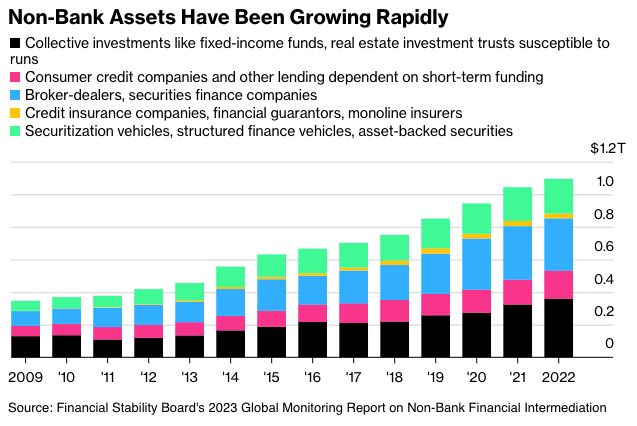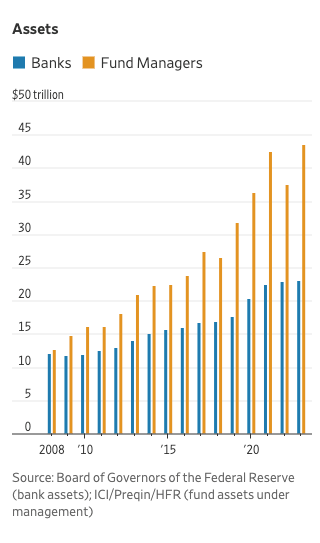A bank has a credit card portfolio. It is happy about that. Fees are good and higher rates mean more interest coming in. There is just one little bummer, and that is the capital it has to hold in reserve incase any cardholders default.
A private credit firm has a bunch of insurance companies as clients. Insurance companies know all about risk and they are willing to take it on. So, the private credit firm goes shopping.
By happenstance (such an underused word), the two of them sit next to each other on a train, and after the bank has poured out its heart about the capital reserve bother, the private credit says, “Why don’t I take the credit cards off your hands?”
So, they strike a deal. The private credit firm buys the credit card portfolio to give the high yields to its insurance clients. The bank gets to keep its customer relationships, the credit card fees, and a check in return. The capital requirement is gone. The bank, the private credit firm, and its insurance clients are all happy. The cardholders are none the wiser.
This is not the bank version of Strangers on a Train (1951) but a 2024 deal for the bank Barclay’s PLC to sell $1.1bn worth of card assets to the private credit firm Blackstone Inc. Soon after this deal was announced, KeyCorp—another lender with too many risk-weighted assets—revealed it was pursuing the same kind of arrangement with Blackstone. And they are not alone. Since the Global Financial Crisis (GFC) in 2008 the amount of non-bank assets out there is estimated to have close to tripled.

In a recent report, the International Monetary Fund (IMF) puts forth an even higher number—just over $2tn—and there are those also joining the party saying $3tn or $4tn for private credit assets on a global scale.
What is more important than absolute size is that the balance in finance has shifted markedly in the past 15 years, and not in favor of traditional banking. WSJ says that before the GFC, the ratio of assets in US banks to fund managers (private and public) was about 1:1, and from what they can piece together, it is now more like 1:2.

One perspective is that if two mature financial institutions consent to transfer risky assets from the party who doesn’t want them anymore to the party that does, and it is within the law and regulation, who are we to say, “Wait a minute!”?
Another view is that while the capital requirement might have disappeared, the same cannot be said for the risk. Banks are regulated to the teeth to minimize systemic risk. Private credit is not. In their report, the IMF lists the following reasons for concern:
-
Borrowers of private credit are typically lower-rated than those with traditional bank loans, if for no other reason than private credit is more expensive and often has a floating rate.
-
Many small or a few concentrated credit losses within private credit—think GFC or the current commercial real estate trouble—can and will be passed onto end-investors.Having agreed to the risk is not the same as being able to bear it well.
-
The hottest trend in private credit will soon be retail funds, that is bringing it to the masses. That can pose a liquidity risk. Just as depositors will pull their savings from the bank when the going gets tough, retail investors will attempt to pull their investments for safer placement or lose them altogether. Unlike deposits, these investments are not insured.
-
It might be that extra layers of jam and frosting don’t sweeten the cake as much as destabilize it. “Only modest amounts of leverage might still face significant capital calls in a downside scenario, with potential transmission to [the] leverage providers”, as they say.
-
Private means secret means no one knows means uncertain means loss of confidence in the asset class. We have been burnt before by financial instruments that looked too good to be true. Also, not all (retail) investors will have the analytical tools to assess the risk.
-
Instability might spill over from private credit. Every big financial institution is diversified because otherwise it would not be big. That means that everybody owns a piece of everybody else. Public fund managers have bought up private funds and own stakes in banks. Banks make complex and ongoing finance arrangements—as the one above—with non-bank entities. If one falls, more might follow.
Extra points if you can guess what the IMF recommends?
Yes, that’s right; disclose and regulate!
Regitze Ladekarl, FRM, is FRG’s Director of Company Intelligence. She has 25-plus years of experience where finance meets technology.

